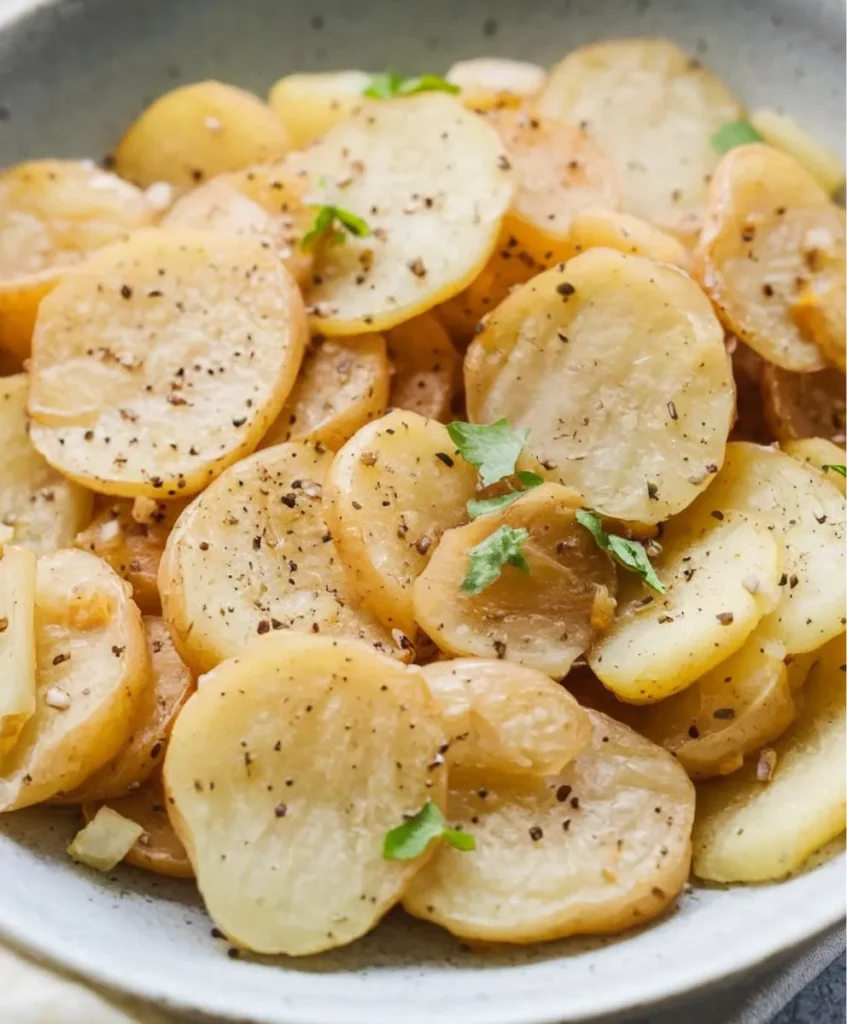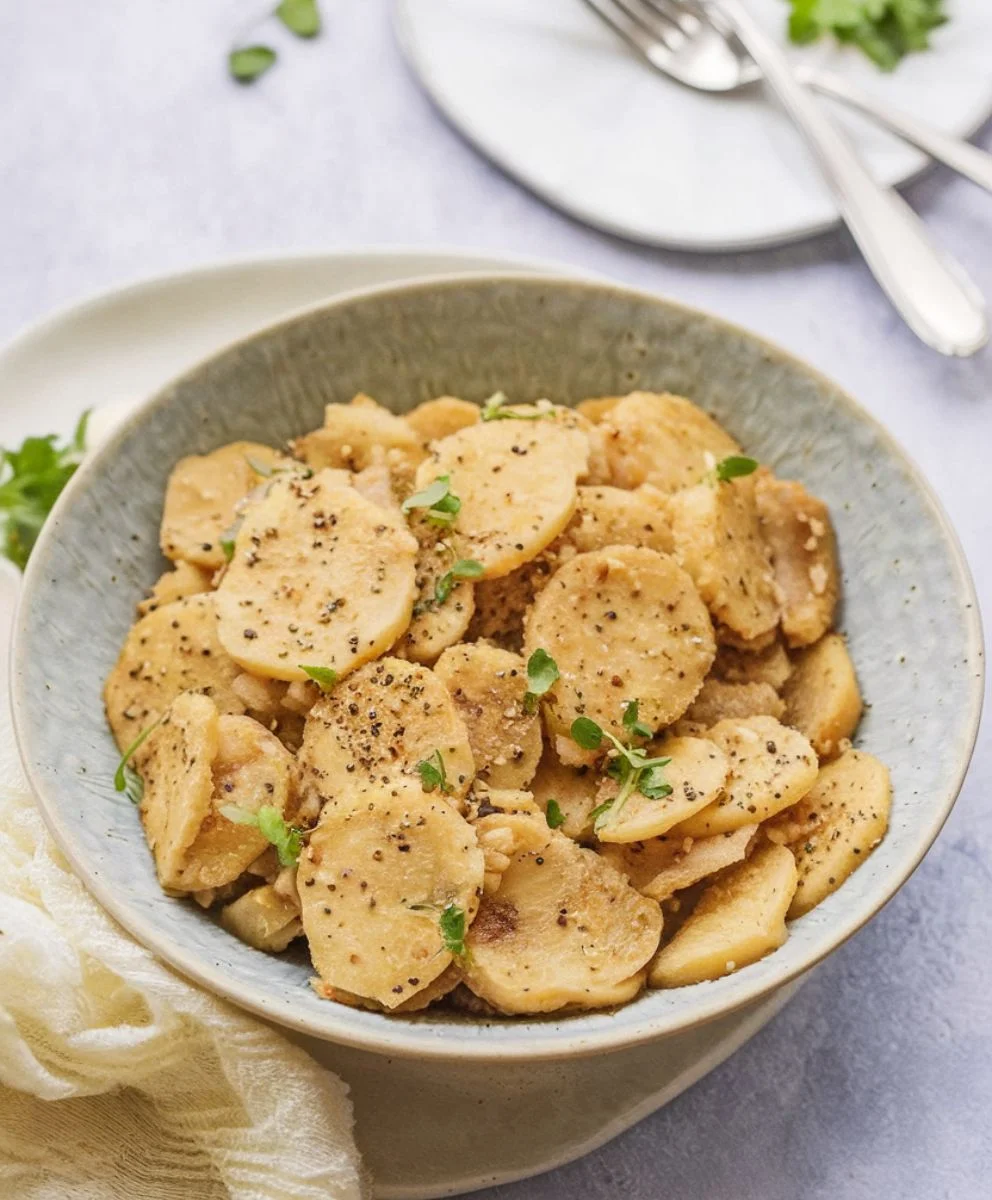Introduction
Few dishes evoke the warmth of home like a steaming plate of smothered potatoes. The rich aroma of caramelized onions mingling with golden, fork-tender potatoes instantly transports you to a place of pure comfort. It’s the kind of dish that doesn’t just satisfy hunger—it soothes the soul.
I remember the first time I tasted smothered potatoes at my grandmother’s kitchen table. She stood by the stove, gently stirring the pan with an almost meditative rhythm. The potatoes, slowly absorbing the buttery, seasoned goodness, transformed into something magical. With each bite, there was a depth of flavor—earthy, savory, and just a hint of sweetness from the onions. It wasn’t just food; it was a memory in the making.
This dish is simplicity at its finest, yet its impact is profound. Whether served as a side or the star of the meal, it carries with it a rich history of Southern comfort and homestyle cooking. The best part? Anyone can make it with just a handful of pantry staples.
Get ready to bring this timeless classic into your own kitchen. Because once you taste the melt-in-your-mouth perfection of smothered potatoes, there’s no going back.
What Kind of Potatoes to Use for Smothered Potatoes
The foundation of any great dish begins with selecting the right ingredients, and smothered potatoes are no exception. Choosing the right variety of potatoes can make all the difference in achieving that perfect balance between creamy, tender insides and lightly crisped edges.
The Best Potatoes for Smothered Potatoes
For a rich, buttery flavor and a smooth, velvety texture, yellow potatoes are an outstanding choice. Their waxy nature ensures they hold their shape well during cooking while absorbing all the savory seasonings without turning into mush.
However, versatility is key in home cooking. If you have Russet potatoes in your pantry, they can also work beautifully. Their higher starch content results in a softer, fluffier texture, which can create a melt-in-your-mouth consistency. Meanwhile, Yukon Golds offer a wonderful middle ground between waxy and starchy, making them a foolproof option. If you prefer a slightly firmer bite, red potatoes are a fantastic alternative, as they maintain their structure while soaking up all the rich flavors of butter, onions, and seasonings.
The Role of Onions in Smothered Potatoes
No plate of smothered potatoes is complete without the sweet, aromatic depth that onions provide. Whether you opt for red, white, or yellow onions, each variety adds its own distinct touch. Yellow onions bring a balance of sweetness and savoriness, caramelizing beautifully as they cook. White onions offer a sharper, more pronounced flavor, perfect for those who enjoy a little bite. Meanwhile, red onions add a hint of mild sweetness and a pop of color to the dish.
The secret to maximizing their impact? Thin slicing. The finer the cut, the better the onions integrate into the dish, infusing every bite with their subtle yet essential presence. As they cook down, they blend seamlessly with the potatoes, creating layers of flavor that make each mouthful irresistibly delicious.
Smothered Potatoes Ingredients

Great dishes don’t always require extravagant ingredients. Sometimes, the most comforting and satisfying meals stem from pantry staples that come together in perfect harmony. Smothered potatoes are a prime example—an unfussy yet deeply flavorful dish that transforms simple ingredients into something exceptional.
Essential Ingredients
Potatoes
The star of the dish, potatoes provide the hearty foundation that makes smothered potatoes so satisfying. Whether you choose yellow, Russet, Yukon Gold, or red potatoes, the key is slicing them evenly to ensure uniform cooking. Their natural starchiness helps create a rich, velvety texture as they slowly absorb the flavors around them.
Onion
A crucial flavor-enhancer, onions bring a hint of sweetness and depth that balance out the earthiness of the potatoes. As they cook, they soften and caramelize, infusing the dish with layers of rich, savory goodness. Whether you choose yellow, white, or red onions, make sure to slice them thinly to allow them to meld seamlessly into the dish.
Garlic
Few ingredients add warmth and aroma quite like garlic. As it sautés, it releases its signature fragrance and infuses the potatoes with a subtly pungent, nutty undertone. Freshly minced garlic works best, but in a pinch, garlic powder can be used for a milder, more evenly distributed flavor.
Olive Oil
A drizzle of olive oil ensures that everything cooks to golden perfection. It helps the potatoes crisp up slightly on the edges while keeping them soft and buttery on the inside. For a richer taste, you can substitute with butter or a mix of both.
Salt & Black Pepper
Seasoning is the backbone of any dish, and here, salt and freshly ground black pepper do more than just enhance the natural flavors. The salt draws out moisture from the potatoes, making them tender, while the black pepper adds a subtle kick that ties everything together.
Optional Additions for Extra Flavor
While the basic version of smothered potatoes is already full of comforting flavors, there’s always room for creativity.
Herbs
Fresh or dried herbs can take this dish to the next level. Thyme, rosemary, parsley, and oregano all add their own unique touch—thyme brings a hint of earthiness, rosemary offers a piney aroma, parsley adds freshness, and oregano provides a slightly peppery undertone.
Spices
If you enjoy bold flavors, consider adding paprika for a mild smokiness, cayenne pepper for a subtle heat, or garlic powder for an extra punch of savory depth. For a Southern-inspired twist, a sprinkle of Creole or Cajun seasoning can add warmth and complexity.
How to Make Smothered Potatoes

Smothered potatoes are a simple yet incredibly flavorful dish, defined by their slow cooking process under a lid, allowing them to become tender, infused with flavor, and irresistibly comforting. While a cast-iron casserole dish is ideal for achieving deep, caramelized notes, any non-stick skillet or pot will work just as well. The key is patience—allowing the potatoes to cook slowly while absorbing all the rich, savory flavors.
Step 1: Prepare and Start Cooking
Before you begin, prep all your ingredients—peel and slice the potatoes, chop the onions, and have your seasoning measured out. This ensures a smooth cooking process without unnecessary delays.
Heat olive oil in a skillet over medium heat until it shimmers. Carefully add the sliced potatoes and onions, spreading them out in an even layer. Immediately cover with a lid to trap steam, which helps soften the potatoes and infuse them with the onion’s sweetness. Let them cook undisturbed for a few minutes to develop a light golden color on the bottom.
Step 2: Check and Flip Regularly
Since potatoes can easily burn if left unchecked, monitor them closely. Every few minutes, gently flip them using a heat-resistant wooden or silicone spatula. This ensures they cook evenly without sticking or breaking apart. Keep an eye on the heat level—adjust if necessary to prevent scorching while allowing a light caramelization to form.
Step 3: Add Liquid and Continue Cooking
Once the potatoes have softened slightly and turned lightly golden, pour in ¼ cup of water or stock, then cover the pan again. This step introduces moisture, allowing the potatoes to steam while absorbing additional flavor. If using vegetable or chicken stock, it adds a richer depth to the dish.
Let them cook for several more minutes, ensuring they absorb the liquid without drying out. If needed, add small amounts of liquid in increments to maintain the perfect balance between tenderness and moisture.
Step 4: Final Seasoning and Finishing Touches
As the potatoes near doneness, remove the lid and stir in minced garlic, salt, and black pepper. Cooking without the lid at this stage allows excess moisture to evaporate, helping the potatoes develop a more robust texture—some slices becoming buttery-soft, while others retain a bit of bite. Stir occasionally, ensuring the seasonings distribute evenly.
When the potatoes are fork-tender and the thinnest slices begin to break down into a velvety consistency, remove from heat. This contrast in texture is what makes smothered potatoes so satisfying.
Step 5: Serve and Enjoy
For an extra burst of flavor, top with fresh herbs like parsley, chives, or thyme. A spoonful of sour cream adds a tangy contrast, while a drizzle of pesto introduces an herby richness. Serve hot as a side dish or enjoy them as a comforting meal on their own.
With just a few simple steps, you’ll have a dish that’s rich, satisfying, and packed with rustic charm.
Smothered Potatoes and Sausage: A Flavorful Twist

If you love smothered potatoes, then adding sausage takes this dish to the next level. The rich, smoky flavors of sausage perfectly complement the creamy, tender potatoes, creating a hearty and satisfying meal. This Southern-inspired variation is a classic comfort dish, packed with deep, savory flavors that come together effortlessly.
Why Add Sausage?
Sausage not only adds protein but also infuses the dish with extra depth and richness. As it browns, it releases flavorful oils and seasoning into the pan, enhancing the overall taste of the potatoes and onions. Whether you prefer a mild, smoky, or spicy sausage, this addition transforms smothered potatoes into a complete, well-rounded dish.
Choosing the Right Sausage
Different sausages bring unique flavors to the dish:
- Smoked sausage (such as andouille or kielbasa) adds deep, bold flavor.
- Spicy sausage (like chorizo or Cajun-style links) brings heat and complexity.
- Mild breakfast sausage provides a more subtle, buttery taste.
How to Cook the Sausage
Slice the sausage into thin rounds or bite-sized chunks. Heat a skillet over medium heat and add the sausage directly—no oil needed, as it will release its own fat. Let it brown undisturbed for a couple of minutes, then flip to develop a deep, golden crust. Stir occasionally to ensure even cooking.
Once fully browned and cooked through, remove the sausage and set it aside. Leave the rendered fat in the pan—it will add rich, smoky flavor to the potatoes and onions.
Storage Tips for Smothered Potatoes
If you find yourself with leftovers, storing smothered potatoes properly will ensure they retain their flavor and texture for later enjoyment.
- Refrigeration – Place cooled smothered potatoes in an airtight container and store them in the refrigerator for up to 3–4 days. Keeping them sealed helps prevent them from drying out while preserving their flavor.
- Freezing – While smothered potatoes are best enjoyed fresh, they can be frozen for longer storage. Arrange them in a single layer on a baking sheet, freeze until firm, then move them to a freezer-safe bag. They will stay fresh and usable for as long as two months.They will remain good for up to two months.
- Reheating – To restore their soft texture, reheat smothered potatoes in a skillet over medium heat with a little butter or broth. For a quicker method, microwave them in 30-second intervals, stirring between each round. If reheating from frozen, allow them to thaw in the refrigerator overnight before warming them up.
Smothered Potatoes recipe
Looking for a hearty and flavorful side? Smothered Potatoes are the answer. Slow-cooked with onions and spices, they’re easy to make and packed with taste.
- Prep Time: 15 mins
- Cook Time: 25 mins
- Total Time: 40 mins
- Yield: 6 servings
- Category: Dinner
- Method: Stovetop
- Cuisine: American
Ingredients
Olive Oil (2 Tbsp, Not Extra Virgin): A higher smoke point prevents burning and ensures even cooking while adding subtle richness.
Potatoes (4 Medium, Peeled & Sliced ⅛-Inch Thick): Thin slices cook evenly, creating a creamy yet tender texture. Yukon Gold, Russet, or red potatoes work best.
Yellow Onion (1 Medium, Sliced into Half Moons): Caramelizes beautifully, infusing the dish with sweetness and depth.
Water or Stock (¼ Cup): Creates steam for softness while enhancing flavor—vegetable or chicken stock adds extra richness.
Garlic (2 Cloves, Minced or Crushed): Brings warmth and depth; use minced for a stronger bite or crushed for a milder infusion.
Salt (1 Tsp) & Black Pepper (½ Tsp): Balances and enhances all flavors, with black pepper adding a subtle kick.
These simple ingredients come together to create a perfectly seasoned, comforting dish.
Instructions
Cooking smothered potatoes is a simple yet rewarding process that transforms basic ingredients into a rich, comforting dish. The key lies in slow-cooking the potatoes until they reach a perfect balance of softness and caramelized flavor. Follow these steps to achieve tender, flavorful potatoes with a melt-in-your-mouth texture.

In a large skillet, heat olive oil over medium heat. Make sure the oil is hot before adding the potatoes—this helps them develop a light golden crust while preventing them from becoming soggy.
Once the oil is shimmering, add the sliced potatoes and onions in an even layer. Stir gently to coat them in oil, then cover the skillet with a lid. This traps steam, allowing the potatoes to soften while the onions release their natural sweetness.
Let them cook for about 8 minutes, checking frequently. Gently flip the potatoes to prevent sticking or burning, ensuring they cook evenly. Be careful not to over-stir, as this may cause them to break apart too soon.
Pour in ¼ cup of water or stock, then cover the skillet again. This step intensifies the flavor, as the liquid helps deglaze the pan, pulling up any browned bits from the bottom. The moisture also keeps the potatoes tender and prevents them from drying out. Let them simmer until the liquid is mostly absorbed.
As the potatoes near full tenderness, remove the lid and stir in garlic, salt, and black pepper. Cooking without the lid at this stage allows excess moisture to evaporate, helping the potatoes develop a slightly crisp exterior while the thinner slices turn delectably soft. Stir occasionally to ensure the seasonings distribute evenly.
Continue cooking until the potatoes are fully done—the thinner slices should be slightly mushy, while the thicker ones remain fork-tender. This contrast in texture is what makes smothered potatoes so comforting.
Remove from heat and serve immediately. For an extra touch of flavor, top with fresh herbs, a dollop of sour cream, or a spoonful of pesto. These additions enhance the dish’s richness while adding a fresh, vibrant finish.

Notes
Perfecting smothered potatoes is all about technique and attention to detail. While the recipe itself is simple, a few key considerations can make a significant difference in achieving the best texture and flavor. Below are essential tips to ensure your dish turns out perfectly every time.
- Potato Selection
While any variety of potatoes can be used, yellow potatoes are the preferred choice due to their creamy texture and slightly buttery taste. Their waxy nature helps them hold their shape well during cooking. However, if you only have Russet or red potatoes on hand, they will still work. Russets tend to be softer and fluffier, while red potatoes retain a firmer bite.
- Handling Potatoes with Care
Thinly sliced potatoes can be delicate, so gentle handling is key to keeping them intact. When flipping or stirring, use a heat-resistant silicone or wooden spatula to prevent breaking. Avoid over-stirring, as this can cause them to turn mushy before they’ve had a chance to fully cook.
- Enhancing the Flavor
For an extra layer of depth, consider adding spices such as smoked paprika, garlic powder, or Cajun seasoning. These seasonings introduce warmth and a hint of smokiness, elevating the dish beyond its classic simplicity. A pinch of red pepper flakes can also add a subtle heat for those who enjoy a spicier kick.
- Consistent Slicing for Even Cooking
Uniform slices ensure even cooking, preventing some pieces from turning mushy while others remain undercooked. Using a mandoline slicer is the easiest way to achieve consistent ⅛-inch slices. If slicing by hand, take your time to keep the pieces as even as possible.
- Monitoring the Liquid
Keep an eye on the liquid levels in the skillet. If the water or stock evaporates too quickly before the potatoes are fully tender, add a small amount at a time to maintain the steaming effect. This will keep the potatoes moist while preventing them from sticking or burning.
- Serving Suggestions
Smothered potatoes are incredibly versatile and pair well with a variety of toppings. Try garnishing with fresh herbs like parsley, chives, or thyme for a pop of color and freshness. A dollop of sour cream adds a creamy tang, while pesto brings a bold, herby richness. For extra indulgence, sprinkle with grated cheese or serve alongside crispy bacon.
Nutrition
- Serving Size: 6
- Calories: 228
- Sugar: 3g
- Sodium: 12mg
- Fat: 5g
- Saturated Fat: 1g
- Carbohydrates: 41g
- Fiber: 3g
- Protein: 5g
Frequently Asked Questions
Can I make smothered potatoes without onions?
Yes! While onions add depth and sweetness, you can omit them or replace them with bell peppers, shallots, or leeks for a different flavor profile
How can I make them crispy instead of soft?
To get crispy edges, remove the lid during the final minutes of cooking and let the potatoes cook uncovered. You can also pan-fry them in a little extra oil before serving.
How can I stop potatoes from sticking to the pan while cooking?
Use a non-stick or well-seasoned cast-iron skillet, and avoid stirring too frequently. Adding a bit of oil or butter can also help create a nice, non-stick surface.
Is it possible to substitute sweet potatoes for regular potatoes?
Absolutely! Sweet potatoes add a natural sweetness and pair well with cinnamon, nutmeg, or smoked paprika. They will cook a little faster than regular potatoes, so keep an eye on them.
What is the best oil to use?
Olive oil, butter, or a combination of both works well. Butter adds richness, while olive oil prevents burning. You can also use bacon fat or ghee for extra flavor.
Can I make smothered potatoes in the oven?
Yes! To bake them, layer the sliced potatoes and onions in a greased baking dish, season them, and add a little broth or water. Cover with foil and bake at 375°F (190°C) for about 35–40 minutes. Remove the foil in the last 10 minutes for a lightly crisped top.
Can I make smothered potatoes vegan?
Yes! Simply use vegetable stock instead of chicken stock and olive oil or vegan butter instead of regular butter. You can also add mushrooms or plant-based sausage for extra flavor.
Conclusion
Few dishes evoke warmth and nostalgia quite like smothered potatoes. Their buttery texture, golden caramelized onions, and deep, savory flavors create the perfect blend of homestyle comfort. Whether served as a hearty side dish, a breakfast essential, or the star of a meal, their versatility ensures they remain a timeless favorite across generations.
One of the best things about smothered potatoes is their adaptability. From the type of potatoes used to the seasoning combinations, this dish can be tailored to suit every palate. Some prefer them soft and creamy, while others enjoy a hint of crispness on the edges. For an even heartier variation, smothered potatoes and sausage bring a smoky depth that enhances the dish’s rustic appeal. A few simple additions, like cheese or fresh herbs, can elevate the flavors even further.
For those wondering how to make smothered potatoes, the process is refreshingly simple. A few pantry staples—potatoes, onions, garlic, and seasonings—come together effortlessly in one pan. Cooking them low and slow allows the flavors to meld beautifully, creating a dish that is both rich and satisfying. Whether you’re following a classic smothered potatoes recipe or adding your own twist, the result is always a comforting, homemade delight.
If you love experimenting with bold flavors, consider pairing smothered potatoes with a unique dish like Pickle Pie Pizza. The tangy bite of pickles, creamy cheese, and a perfectly crisp crust contrast beautifully with the savory richness of smothered potatoes, making for an unexpected yet delicious meal combination.
Leave a comment
Your email address will not be published. Required fields are marked*


